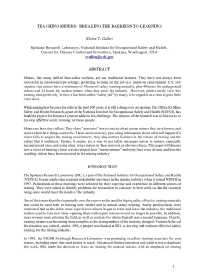Mining Publication: Teaching Miners: Breaking the Barriers to Learning
Original creation date: October 2003
Miners, like many skilled blue-collar workers, are not traditional learners. They have not always been successful in classroom-type settings, preferring to learn on the job in a hands-on environment. U.S. law requires that miners have a minimum of 8 hours of safety training annually, plus 40 hours for underground miners and 24 hours for surface miners when they enter the industry. However, miners rarely view this training time positively. In fact, it has been called "safety jail" by many, who regard it as a time to get a little extra sleep.
While mining has become far safer in the past 100 years, it is still a dangerous occupation. The Office for Mine Safety and Health Research, a part of the National Institute for Occupational Safety and Health (NIOSH), has funded a project for the past 4 years to address this challenge. The purpose of the research was to find a way to develop effective safety training for these people.
Miners are born story tellers. They share "near miss" stories, stories about master miners they have known, and stories about how things used to be. These stories not only pass along information about what will happen if a miner fails to respect the mining environment, they also instruct listeners in the culture of mining and the values that it embraces. Stories, it seems, are a way to get safety messages across to miners, especially inexperienced ones, and using older, wiser miners in these stories is an obvious choice. This paper will discuss how a series of training videos was developed, how "master miners" and story lines were chosen, and how the resulting videos have been received in the mining industry.
Authors: ET Cullen
Conference Paper - October 2003
NIOSHTIC2 Number: 20024064
Minesafe International 2003. Perth, Western Australia: The Chamber of Minerals and Energy of Western Australia, Inc., 2003 Oct; :1-8
See Also
- Origin of Mining-Induced Fractures Through Macroscale Distortion
- Overview of U.S. Research on Three Approaches to Ensuring That Coal Miners Work Safely: Management, Workplace Design and Training
- Performance of a Light-scattering Dust Monitor in Underground Mines
- Recent National Institute for Occupational Safety and Health Research Using Ground Penetrating Radar for Detection of Mine Voids
- Research Report on Refuge Alternatives for Underground Coal Mines
- Review of Recent Research on Organizational and Behavioral Factors Associated With Mine Safety
- Technology News 535 - NIOSH Releases New Educational Video: Escape from Farmington No. 9: An Oral History
- Technology News 537 - NIOSH Develops New Mine Refuge Chamber Training
- Underground Coal Mine Disasters 1900-2010: Events, Responses, and a Look to the Future
- Work Sampling Applied to a Human Factors Analysis of Mine Worker Positioning
- Page last reviewed: 9/21/2012
- Page last updated: 9/21/2012
- Content source: National Institute for Occupational Safety and Health, Mining Program


 ShareCompartir
ShareCompartir
